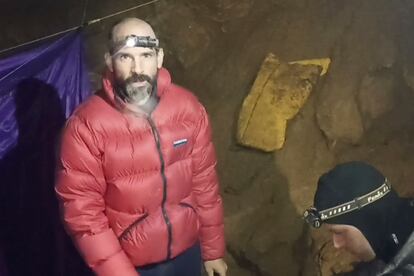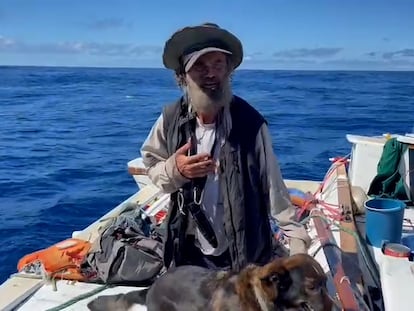Trapped US explorer thanks authorities for saving his life in emotional video from Turkish cave
Experienced caver Mark Dickey suddenly became ill during an expedition with a handful of others, including three other Americans, in the Morca cave in southern Turkey’s Taurus Mountains

Rescuers from across Europe rushed to a cave in Turkey on Thursday, launching an operation to save an American researcher who became trapped around 1,000 meters (3,000 feet) below the surface after suffering stomach bleeding. Experienced caver Mark Dickey, 40, suddenly became ill during an expedition with a handful of others, including three other Americans, in the Morca cave in southern Turkey’s Taurus Mountains, the European Association of Cave Rescuers said.
In a video message from inside the cave and made available Thursday by Turkey’s communications directorate, Dickey thanked the caving community and the Turkish government for their efforts. “Hi! Mark Dickey from nearly a thousand meters,” Dickey said. “The caving world is a really tight-knit group, and it’s amazing to see how many people have responded on the surface.”
“We’re still waiting for communications actually to reach down here,” he continued. “So right now it’s a day or two days of travel for information to get back and forth. I don’t quite know what’s happened, but I do know that the quick response of the Turkish government to get the medical supplies that I need, in my opinion, saved my life. I was very close to the edge.”
Dickey, who had been bleeding and losing fluid from his stomach, has stopped vomiting and has eaten for the first time in days, according to a New Jersey-based cave rescue group he’s affiliated with. It’s unclear what caused his medical issue.
The New Jersey Initial Response Team said Dickey is “very sick” and is located about 1,000 meters below the surface. The rescue will require many teams and constant medical care, the group said.
Communication with Dickey takes about five to seven hours and is carried out by runners, who go from Dickey to the camp below the surface, where a telephone line to speak with the surface has been set up.
The New Jersey group says the cave is cold — about 4-6 C (39-42 F).
Dinko Novosel, a Croatian cave rescuer who is head of the European Association of Cave Rescuers, said it will be a challenge to successfully rescue Dickey.
The operation to bring him up from the depths involves rescue teams from Bulgaria, Croatia, Hungary, Italy, Poland and Turkey.
Dickey experienced the gastrointestinal bleeding during his descent into the cave, and he’s unable to hoist himself out on his own, the European Cave Rescue Association said on its website.
The group described Dickey as “a highly trained caver and a cave rescuer himself” who is well known as a cave researcher, or speleologist, from his participation in many international expeditions. He is secretary of the association’s medical committee.
Experts say the rescue operation could take days or even weeks, depending on conditions.
Dickey was on an expedition mapping the 1,276-meter (4,186-feet) deep Morca cave system for the Anatolian Speleology Group Association (ASPEG) when he ran into trouble about 1,000 meters down, according to Yusuf Ogrenecek of the Speleological Federation of Turkey.
Ogrenecek told The Associated Press later Thursday that Dickey’s condition had stabilized and was improving. He said the American was in “good spirits” and doctors would decide if Dickey can leave the cave on a stretcher or under his own power.
Turkish disaster relief agency AFAD and rescue team UMKE are working with Turkish and international cavers on a plan to hoist Dickey out of the cave system, the rescue association said.
The rescue effort currently involves more than 170 people, including doctors, paramedics who are tending to Dickey and experienced cavers, Ogrenecek said, adding that the rescue operation could take up to two to three weeks.
A team of rescuers from Italy’s National Alpine and Speleological Rescue Team will be flying to Turkey on Thursday night. A total of around 50 rescuers will be at the entrance of the cave early Friday, ready to participate in the operation directed by Turkish authorities.
Marton Kovacs of the Hungarian Cave Rescue Service said that the cave is being prepared for his safe extraction. Narrow passages are being widened to accommodate a stretcher, and the danger of falling rocks is also being addressed.
The rescue teams hope that the extraction can begin on Saturday or Sunday. Kovacs said that lifting Dickey will likely take several days, and that several bivouac points are being prepared along the way so that Dickey and rescue teams can rest.
The cave has been divided into several sections, with each country’s rescue team being responsible for one section.
The Hungarian Cave Rescue Service, made up of volunteer rescuers, was the first to arrive at Dickey’s location and provided emergency blood transfusions to stabilize his condition. An additional Hungarian team of 15–20 rescuers will leave Hungary on Thursday evening on a military plane provided by the government and arrive at the rescue site on Friday morning, Kovacs said.
Six mountain rescuers, including two medics, have left for Antalya to help in the rescue operation, Jerzy Siodlak, the head of Poland’s mountain rescue service, GOPR, said Wednesday on Radio RMF24.
Thirteen other rescuers from southern Poland are also ready to join the rescue operation, GOPR authorities said. Siodlak noted the operation will be a challenging one given the condition of the American and the need to keep him medically fit for the rescue operation in difficult conditions.
Sign up for our weekly newsletter to get more English-language news coverage from EL PAÍS USA Edition
Tu suscripción se está usando en otro dispositivo
¿Quieres añadir otro usuario a tu suscripción?
Si continúas leyendo en este dispositivo, no se podrá leer en el otro.
FlechaTu suscripción se está usando en otro dispositivo y solo puedes acceder a EL PAÍS desde un dispositivo a la vez.
Si quieres compartir tu cuenta, cambia tu suscripción a la modalidad Premium, así podrás añadir otro usuario. Cada uno accederá con su propia cuenta de email, lo que os permitirá personalizar vuestra experiencia en EL PAÍS.
¿Tienes una suscripción de empresa? Accede aquí para contratar más cuentas.
En el caso de no saber quién está usando tu cuenta, te recomendamos cambiar tu contraseña aquí.
Si decides continuar compartiendo tu cuenta, este mensaje se mostrará en tu dispositivo y en el de la otra persona que está usando tu cuenta de forma indefinida, afectando a tu experiencia de lectura. Puedes consultar aquí los términos y condiciones de la suscripción digital.
More information
Últimas noticias
Most viewed
- Sinaloa Cartel war is taking its toll on Los Chapitos
- Oona Chaplin: ‘I told James Cameron that I was living in a treehouse and starting a permaculture project with a friend’
- Reinhard Genzel, Nobel laureate in physics: ‘One-minute videos will never give you the truth’
- Why the price of coffee has skyrocketed: from Brazilian plantations to specialty coffee houses
- Silver prices are going crazy: This is what’s fueling the rally










































